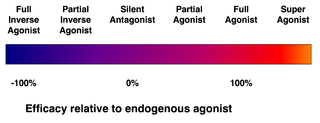
Intrinsic activity
Encyclopedia

Drug
A drug, broadly speaking, is any substance that, when absorbed into the body of a living organism, alters normal bodily function. There is no single, precise definition, as there are different meanings in drug control law, government regulations, medicine, and colloquial usage.In pharmacology, a...
-receptor
Receptor (biochemistry)
In biochemistry, a receptor is a molecule found on the surface of a cell, which receives specific chemical signals from neighbouring cells or the wider environment within an organism...
complex to produce a maximum functional response. This must be distinguished from the affinity, which is a measure of the ability of the drug to bind to its molecular target, and the EC50, which is a measure of the potency
Potency (pharmacology)
In the field of pharmacology, potency is a measure of drug activity expressed in terms of the amount required to produce an effect of given intensity. A highly potent drug evokes a larger response at low concentrations, while a drug of lower potency evokes a small response at low concentrations...
of the drug and which is proportional to both efficacy and affinity. This use of the word "efficacy" was introduced by Stephenson (1956) to describe the way in which agonist
Agonist
An agonist is a chemical that binds to a receptor of a cell and triggers a response by that cell. Agonists often mimic the action of a naturally occurring substance...
s vary in the response they produce, even when they occupy the same number of receptors. High efficacy agonists can produce the maximal response of the receptor system while occupying a relatively low proportion of the receptors in that system.
Agonists of lower efficacy are not as efficient at producing a response from the drug-bound receptor, by stabilizing the active form of the drug-bound receptor. Therefore, they may not be able to produce the same maximal response, even when they occupy the entire receptor population, as the efficiency of transformation of the inactive form of the drug-receptor complex to the active drug-receptor complex may not be high enough to evoke a maximal response. Since the observed response may be less than maximal in systems with no spare receptor reserve, some low efficacy agonists are referred to as partial agonists.
However, it is worth bearing in mind that these terms are relative - even partial agonists may appear full agonists in a different system/experimental setup, as when the number of receptors increases, there may be enough drug-receptor complexes for a maximum response to be produced, even with individually low efficacy of transducing the response. There are actually relatively few true full agonists or silent antagonists; many compounds usually considered to be full agonists (such as DOI
2,5-Dimethoxy-4-iodoamphetamine
2,5-dimethoxy-4-iodoamphetamine is a psychedelic drug and a substituted amphetamine of the phenethylamine family. It is also a powerful anti-inflammatory that is effective at doses on the order of 100 micrograms in humans, far below its effective dose as a psychedelic. Despite being a substituted...
) are more accurately described as high efficacy partial agonists, as a partial agonist with efficacy over ~80-90% is indistinguishable from a full agonist in most assays. Similarly many antagonists (such as naloxone
Naloxone
Naloxone is an opioid antagonist drug developed by Sankyo in the 1960s. Naloxone is a drug used to counter the effects of opiate overdose, for example heroin or morphine overdose. Naloxone is specifically used to counteract life-threatening depression of the central nervous system and respiratory...
) are in fact partial agonists or inverse agonists, but with very low efficacy (less than 10%). Compounds considered partial agonists tend to have efficacy in between this range.
| Ligand | Description | % Efficacy (E) | ||||
|---|---|---|---|---|---|---|
| Super agonist Superagonist An irreversible agonist is a type of agonist that binds permanently to a receptor in such a manner that the receptor is permanently activated. It is distinct from a mere agonist in that the association of an agonist to a receptor is reversible, whereas the binding of an irreversible agonist to a... |
Efficacy greater than the endogenous agonist Endogenous agonist In pharmacology, an endogenous agonist for a particular receptor is a compound naturally produced by the body which binds to and activates that receptor... |
E | > | 100 | ||
| Full agonist | Efficacy equal to the endogenous agonist | E | = | 100 | ||
| Partial agonist Partial agonist Partial agonists bind and activate a given receptor, but have only partial efficacy at the receptor relative to a full agonist... |
Efficacy less than the endogenous agonist | 0 | < | E | < | 100 |
| Silent antagonist | Affinity but no efficacy | E | = | 0 | ||
| Inverse agonist Inverse agonist In the field of pharmacology, an inverse agonist is an agent that binds to the same receptor as an agonist but induces a pharmacological response opposite to that agonist.... |
Inverse efficacy | E | < | 0 | ||

